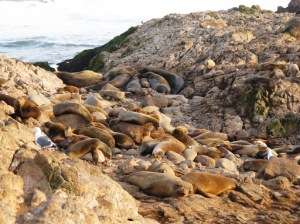Winter Season Begins
December 11, 2009
 The 2010 winter crew has arrived at SEFI, eager to being monitoring this season’s northern elephant seal reproduction. We welcomed the continued presence of California and Steller sea lions at Sand Flat and Mirounga Beach, our main elephant seal breeding beaches. Northern fur seals have even been spotted twice at Sand Flat over the past year. In spring 2009, PRBO biologists counted the largest number of California sea lions ever on the island, with a high of a whopping 13,000 individuals (the average number is about 2,500). While overall numbers of sea lions are lower this year, the concerted efforts of SEFI’s human residents to minimize disturbance has paid off, and sea lions are hauling out on new areas of the island. Sometimes, however, they decide to hang out in rather inopportune places — like on our front path, on the back doormat, and on the top of our new Sea Lion Cove blind!
The 2010 winter crew has arrived at SEFI, eager to being monitoring this season’s northern elephant seal reproduction. We welcomed the continued presence of California and Steller sea lions at Sand Flat and Mirounga Beach, our main elephant seal breeding beaches. Northern fur seals have even been spotted twice at Sand Flat over the past year. In spring 2009, PRBO biologists counted the largest number of California sea lions ever on the island, with a high of a whopping 13,000 individuals (the average number is about 2,500). While overall numbers of sea lions are lower this year, the concerted efforts of SEFI’s human residents to minimize disturbance has paid off, and sea lions are hauling out on new areas of the island. Sometimes, however, they decide to hang out in rather inopportune places — like on our front path, on the back doormat, and on the top of our new Sea Lion Cove blind!
Last year, sea lions took up residence on Sand Flat and Mirounga Beach and surrounding terraces, and have been there ever since. The sea lions on our main breeding beaches have changed the way we monitor elephant seal survival and reproduction. Because sea lions and fur seals are more skittish than elephant seals, we now read seal tags and count e-seal cows and pups by hiding behind rocks to avoid being seen by the sea lions.
This week, PRBO biologist Derek Lee and the rest of the winter crew began re-building a blind on the rocky outcrop overlooking Sand Flat. Using the blind, we can comfortably remain hidden while reading e-seal tags and monitoring the arrival and departure of cows and the births of pups. We also can keep tabs on the adult e-seal males battling for dominance.
 We are grateful that the sea lions and fur seals are venturing back into places they may have abandoned many decades ago due to human disturbance. We are merely visitors to this world-renowned biologically rich haven for marine life.
We are grateful that the sea lions and fur seals are venturing back into places they may have abandoned many decades ago due to human disturbance. We are merely visitors to this world-renowned biologically rich haven for marine life.
It is their island, after all.



